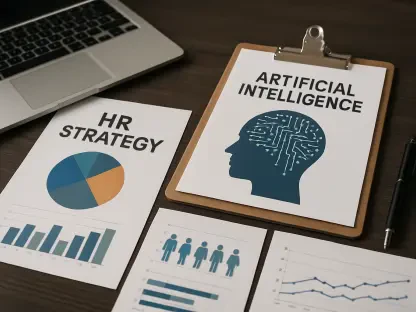In an era where data drives decision-making across various business functions, the Human Resources (HR) sector remains one of the slower adopters of data analytics. Despite the transformative potential and clear benefits that data-driven decision-making can offer, many HR departments continue to rely on intuition and traditional methods. However, the landscape is shifting rapidly as the global HR analytics market is projected to grow significantly, reaching $6.3 billion by 2030. The urgent need for HR departments to embrace these advanced tools cannot be overstated. This article delves into the manifold benefits and practical steps for integrating data analytics in HR, aimed at enhancing organizational performance and boosting employee satisfaction.
The Current State of Analytics in HR
Historically, HR departments have lagged behind other business sectors in adopting data analytics. This reluctance can be traced back to a deep-seated reliance on human intuition and anecdotal evidence, coupled with a general lack of familiarity with advanced technological tools. Nevertheless, the prevailing trend towards data-centric decision-making across various industries is mounting pressure on HR to adapt. With HR analytics market predictions indicating growth to $6.3 billion by the year 2030, it becomes evident that transitioning towards these technological advancements is no longer just desirable but essential for remaining competitive.The traditional methodologies in HR, hinged largely on gut feelings and anecdotal evidence, often result in biased and suboptimal decisions. As organizations pivot towards more data-driven frameworks, these conventional methods are increasingly proving to be ineffective. By adopting data analytics, HR departments can transcend these limitations, making way for evidence-based strategies that yield measurable outcomes. The shift from intuition-based to data-driven decisions marks a critical evolution in the HR domain, laying the groundwork for enhanced organizational efficacy and greater employee satisfaction.
Overcoming Gender Bias with Data
One compelling example of how data analytics can revolutionize HR practices is evident in addressing gender bias within internal job applications. A leading pharmaceutical company found itself grappling with a scenario where male employees frequently overstated their qualifications, while qualified female employees hesitated to apply due to fears of bias. To tackle this issue, the company partnered with a U.S.-based software provider specializing in employment analytics, leveraging data to objectively assess and elevate overlooked female candidates. This strategic intervention not only addressed inherent gender bias but also led to a substantial increase in the promotion of qualified women, thereby fostering a more inclusive and equitable workplace environment.This case study illuminates the power of data analytics to provide objective insights, capable of dismantling entrenched systemic biases within an organization. By capitalizing on workforce data, companies can make equitable, merit-based decisions that promote diversity and inclusion. The use of analytics in this context underscores the potential for data-driven approaches to rectify imbalances and nurture an inclusive corporate culture, making it a vital tool for modern HR departments aiming for comprehensive workforce equity.
Enhancing Employee Experience with Analytics
Data analytics holds the key to significantly improving the employee experience, offering invaluable insights into sentiment and well-being. Tools designed to measure employee satisfaction can help create a supportive work environment, which in turn, translates into enhanced productivity. For example, a security service provider utilized advanced analytics to predict high-risk locations and subsequently optimized its shift-management software. This strategic application resulted in not only improved customer service but also heightened staff morale and a noticeable drop in employee turnover rates.Unstructured data analytics further provide innovative avenues to enhance workplace dynamics. By analyzing CCTV footage, organizations can gain unique insights into how employees interact and collaborate, uncovering informal networks and paving the way for interventions that foster better communication and cooperation. The ability to harness such data fosters a culture of transparency and mutual understanding, ultimately benefiting both employees and the organization. These analytics-driven insights can lead to targeted improvements, thereby making the work environment more conducive to efficiency, engagement, and overall job satisfaction.
Educating HR Leaders on Data Literacy
One of the significant hurdles in adopting data analytics within HR is the pervasive lack of data literacy among HR leaders. Given their crucial role in recruiting and training the next generation of employees, their mastery of data analytics becomes pivotal. A case in point is a consumer electronics company that mandates basic analytics training for all new hires, irrespective of their roles. This foundational approach builds organizational data literacy from the ground up, equipping the workforce to thrive in an increasingly data-driven landscape.Improving data literacy among HR leaders holds transformative potential, enabling them to harness analytics for more informed decision-making. This shift can pivot HR from a primarily transactional function to a strategic partner, significantly contributing to organizational success. As HR leaders become adept in navigating data analytics, they will be better positioned to implement data-driven strategies that align with broader business objectives, thus amplifying their impact and value within the corporate structure.
Navigating Employee Trust and Privacy Concerns
While the advantages of data analytics in HR are considerable, one cannot overlook the associated risks, especially concerning employee trust and privacy. Monitoring tools perceived as intrusive can severely affect employee morale and lead to increased turnover. It is imperative for organizations to ensure that these implementations are communicated transparently, emphasizing the mutual benefits for both employers and employees.Transparency is crucial in mitigating these risks. By clearly articulating the purpose and advantages of data monitoring, organizations can secure employee buy-in and cooperation. When employees comprehend how data analytics can enhance their work environment and career prospects, they are naturally more inclined to embrace these tools. This transparent approach fosters a culture of trust, showing employees that their data is being used responsibly and ethically to improve their professional lives.
Implementing Analytics: Start Small and Scale Gradually
The successful implementation of data analytics in HR often begins with small, well-defined projects. This approach enables organizations to experiment, learn, and build confidence before scaling up to more ambitious initiatives. Early collaboration with IT departments is essential during these initial stages, but as HR professionals become more comfortable with analytics, these projects can progressively evolve into cross-functional collaborations.Adopting a step-by-step approach allows organizations to manage risks effectively and adjust strategies as needed. Starting small also facilitates the development of internal capabilities and provides insights into the impact of analytics on organizational processes. This gradual scaling fosters a more robust and adaptive analytics culture within HR, laying the groundwork for broader and more intricate future initiatives.
Bridging the Skills Gap in Data Analytics
In today’s data-driven world, many business functions have adopted data analytics to enhance their decision-making processes. However, Human Resources (HR) remains one of the slower sectors to embrace this transformation. Despite the significant advantages and transformative potential of data-driven decision-making, HR departments often rely on traditional methods and intuition. This trend is changing rapidly, as the global HR analytics market is estimated to expand considerably, reaching $6.3 billion by 2030. The urgency for HR departments to adopt advanced analytical tools is becoming increasingly evident.Data analytics can revolutionize HR processes, offering numerous benefits. For instance, it can improve hiring practices by predicting candidate success and enhance employee retention through the identification of factors leading to job satisfaction or dissatisfaction. Furthermore, data analytics can streamline performance management by providing objective metrics and insights, ultimately fostering a more engaged and productive workforce.To successfully integrate data analytics into HR, organizations need to follow practical steps. These include investing in relevant technologies, training HR professionals in data literacy, and cultivating a culture that values data-driven decision-making. By doing so, companies can expect significant improvements in organizational performance and employee satisfaction. Embracing HR analytics is not merely a trend but a necessary evolution to stay competitive in an increasingly data-centric world.









